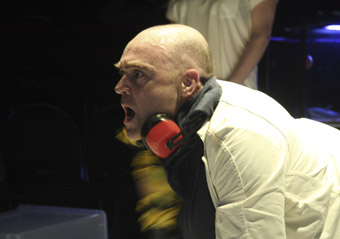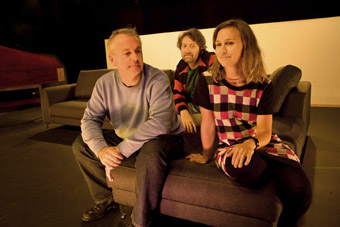observation and its relativities
john bailey: red stitch, ben ellis & ranters at full tilt
{$slideshow} THREE RECENT PRODUCTIONS MOUNTED AS PART OF THE VICTORIAN ARTS CENTRE’S FULL TILT PROGRAM HAD ME PONDERING THE SCIENCE OF INTERPRETATION. THE FIRST, A REMOUNT OF RED STITCH ACTORS THEATRE’S WONDERFUL RED SKY MORNING, WAS A BIT OF A SCHRODINGERIAN CAT. HAVING ALREADY SEEN IT IN ITS INITIAL INCARNATION AT RED STITCH’S TINY HOME IN ST KILDA, I WASN’T SURE HOW IT WOULD SURVIVE WHEN TRANSPLANTED TO THE BIGGER BOX OF THE ARTS CENTRE’S FAIRFAX STUDIO. I’M STILL UNCERTAIN WHETHER IT SURVIVED OR NOT.
red sky morning
I like to think the cat is alive. In Erwin Schrodinger’s famous thought experiment, we are meant to imagine a cat in a box along with poison which may be released without our knowledge. According to the physicist, the cat is both alive and dead until the moment the box is opened and, lo, we can observe the reality. Schrodinger wasn’t advocating the killing of cats, and I hope that nobody’s actually followed through with the experiment. But he was attempting to illustrate the limitations of a science that logically implied the possibility of incommensurable realities existing simultaneously. Which sounds to me suspiciously like art.
The play is, to my mind, one of the finest products of creative collaboration in years. It traces a day in the life of a family of three, all infected with a heart-wrenching depression that takes form in various ways. Mum suffers from a painfully realistic alcoholism that does away with simple clichés of the happy/angry/functional/dysfunctional drunk. Father is a painfully laconic figure whose inability to articulate his feelings has increasingly terrifying effects. Daughter’s teen frustrations make her a social pariah, unable to forge meaningful connections with her parents or peers. There is no obvious source for the dangerous black dog which menaces the family; its effects, however, are all too clear. Red Sky Morning is also very funny.
This is an astounding work of theatre that could only have resulted from an intensive association between its writer, director and performers over a long period of time. It’s exactly the kind of production I would want to see picked up by programs such as Full Tilt, allowing it to be exposed to a wider audience than Red Stitch’s considerable subscriber base alone. But of course I’m biased—having enjoyed its first outing so much, the cat is still alive for me. Transposing Red Sky Morning from a tiny St Kilda theatre to the sizeable Fairfax (which was itself curtained back to half its usual scale in order to maintain the tight forward focus of the original) may have reduced its effectiveness for newcomers, but I sincerely hope that this is a piece with a strong life ahead of it.

Simon King, Poet #7
photo Daisy Noyes
Simon King, Poet #7
poet #7
The second of Full Tilt’s most recent season of programmed works was a more difficult exercise. Ex-Melbourne playwright Ben Ellis has based himself in the UK for a number of years but his recent writing still has strong connections with the work he was producing here. One common thread is the use of apocalyptic scenarios: 2002’s Falling Petals saw the youth of a country town succumbing to a mysterious plague-like illness, while last year’s The Zombie State featured hordes of working-class undead ravaging Melbourne (RT88 online: www.realtimearts.net/article/issue88/9256). His theatre has often employed such imagery for political ends, to comment on the real dynamics and perils of contemporary culture. Like philosopher Slavoj Zizek, I’ve long been wary of the effectiveness of apocalypse as an ideological framing device—it’s all too easy (and disempowering) to imagine that radical change can only occur through a complete upheaval in society. Such scenarios, while undoubtedly terrifying, are seductive in the freedom from conventional morality and social bondage they envision, but are equally fantasies which deter us from imagining actual methods of altering the systems of power that presently exist.
Ellis doesn’t fall prey to this tendency, however, and Poet #7’s setting (or rather, settings) within a world that has undergone a cryptically-referred-to Armageddon are not accomplished simply in order to make crude comments on the problems of modern life. In fact, the setting would seem almost superfluous if it didn’t afford Ellis the chance to produce some wonderfully evocative poetry. The title of the piece refers to a poet recalled by one of the four narrators—a poet destroyed by a bomb blast while clasping the speaker’s hand, and which hand stays unwittingly clasped by the dazed speaker as he runs in terror from the scene.
We learn very little of the titular poet, and over the course of the play we don’t learn an awful lot of its characters either. Ellis’ script gives us four voices that each inhabit a different temporal zone. Though they’re related in various ways, it’s up to the audience to piece together a narrative from these fragmented chronologies. While it’s not unusual for theatre (or other art forms) to play with time in this way, it’s rarer to witness a work in which each character exists in complete temporal isolation.
Poet #7 is a fascinating experiment—appropriate given its lab-type setting and medical-procedural themes—but its consciously high level of formal stylisation will mean that any observer will come away with a different interpretation. Science knows, I haven’t found two people who can agree on what is actually supposed to have occurred in the piece, and responses have ranged from ecstatic to bored. Perhaps, in discovering the narrative ‘truth’ of the work, its aesthetic beauty loses focus—and vice versa. This variety of individual interpretations is itself a kind of Heisenberg Principle given dramatic expression. In any case, it’s the kind of boundary-pushing work seldom seen in a state arts centre.

Affection, Ranters Theatre
photo James Boddington
Affection, Ranters Theatre
affection
Ranters Theatre’s recent works have been just as edgy, but as anyone who witnessed the brilliant Holiday will attest, their unique innovations are so thoroughly approachable that even the most wary of theatregoers will find themselves seduced. Affection isn’t as carefully crafted a work as Holiday, though it has developed from the same practices which informed that piece. It is styled as a hypernaturalistic series of conversations between people who appear as simply themselves—character, plot and backstory are dispensed with, and what we see is exactly what it is. This is harder to accomplish than it sounds. As audiences, we’re trained to look for deeper meanings, subtexts, the relationships and histories of the people we see onstage. Of course, we do this during Affection too, but the casual reticence of Ranters’ method makes us aware of our own role in constructing these narratives. Theatre no longer becomes a case of solving the mystery or finding the secret truth to a text, but instead forces us to consider that our own act of observing brings with it a history that massively affects our understanding of what we see. The Observer Effect, after all, isn’t limited to physics. Art is a science with infinite variables.
Red Stitch Actors Theatre, Red Sky Morning, writer Tom Holloway, director Sam Strong, performers David Whiteley, Sarah Sutherland, Erin Dewar, designer Peter Mumford; Fairfax Studio, June 3-13; Poet No. 7, writer Ben Ellis, director Daniel Schlusser, performers Edwina Wren, Merfyn Owen, Simon King, Georgina Capper, designer Meg White, sound designer, composer Darrin Verhagen, Martin Kay, Nick van Cuylenburg, lighting Kimberly Kwa, costumes Jemimah Reidy; The Black Box, June. 11-20; Ranters Theatre, Affection, text Raimondo Cortese, director, devisor Adriano Cortese, performers, co-devisors Beth Buchannan, Paul Lum, Patrick Moffatt, Anastasia Russel-Head, Heather Bolton The Black Box, Arts Centre, Melbourne, June 1-11
RealTime issue #92 Aug-Sept 2009 pg. 40






